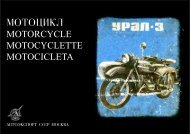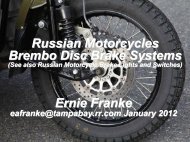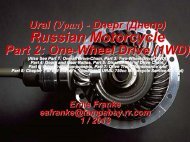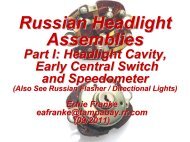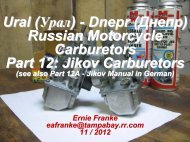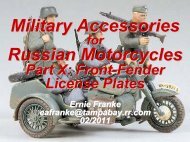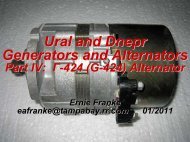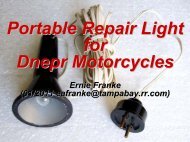Part 2A:PZ-24 and PZ-28 Carburetors - Good Karma Productions
Part 2A:PZ-24 and PZ-28 Carburetors - Good Karma Productions
Part 2A:PZ-24 and PZ-28 Carburetors - Good Karma Productions
Create successful ePaper yourself
Turn your PDF publications into a flip-book with our unique Google optimized e-Paper software.
<strong>PZ</strong>-<strong>24</strong> <strong>and</strong> <strong>PZ</strong>-<strong>28</strong> Carburetor (Карбюратор(Карбюратор)• <strong>PZ</strong>-<strong>24</strong> <strong>and</strong> <strong>PZ</strong>-<strong>28</strong> Are Chinese Knockoffs of Russian K-37's, but Better Made–K-37 Carb Was a Russian Knockoff of the German Graetzin G<strong>24</strong> for the BMW 71–Used in Chang Jiang 750 (CJ750) Motorcycle• CJ750 Was Chinese Knockoff of Russian M-72• Russian M-72 Was Knockoff of German R-71 Motorcycle• Later Replaced by K-38 <strong>and</strong> K-301 / K-302• <strong>PZ</strong>-<strong>24</strong> <strong>and</strong> <strong>PZ</strong>-<strong>28</strong> Characteristics:–Motorcycle has Two <strong>Carburetors</strong>• Right <strong>and</strong> Left-Side Version• Similar, but Mirror-Images–Round-Slide Throttle Valve–Float Chamber (bowl) Offset from Carburetor AxisThe <strong>PZ</strong>-<strong>24</strong> <strong>and</strong> <strong>PZ</strong>-<strong>28</strong> were good substitutes for the K-37 carbsused on the M-72, K-750 <strong>and</strong> MB-750 motorcycles.
German R71 Vergaser (German for Carburetor): Father of Russian K-37K• BMW R71 Motorcycle–746 cc Flathead (SV)–Production: 1938-1941–Father of Ural M-72, which begat the K-750, etc.–2 X Graetzin G<strong>24</strong> (<strong>24</strong> mm) <strong>Carburetors</strong>Y = Rubber SleeveU 1= Cover of Slide-Valve HousingU 2= Screw ConnectionN = Slide Valve Stop ScrewN 1= Locknut for NB = Idling Regulating ScrewB 1= Locknut for BD = Safety Screw in Idling Air ChannelO = Cap Nut with StrainerR = Cover of Float ChamberM = TicklerM 1= Tickler SpringM 2= Split PinL = Float NeedleK = FloatGraetzin G<strong>24</strong> Carburetor“Amal” carburetors were fitted to the German R51, R61 <strong>and</strong> R66 machines<strong>and</strong> the “Graetzin” carburetor to the BMW R71, the father of the Russian M-72.
Chinese <strong>Carburetors</strong> <strong>and</strong> Motorcycles• Three Models of Chang Jiang (CJ) Motorcycles–Chang Jiang M1• Sidevalve (flathead) Engine <strong>and</strong> 6-Volt Electrical System• Clone of the Russian M-72 <strong>and</strong> Closely Resembles the German 1938 BMW R71–Chang Jiang M1M• Sidevalve (flathead) Engine <strong>and</strong> 12-Volt Electrical system–Chang Jiang M1S (or "Super CJ")• Overhead-Valve (OHV) Engine <strong>and</strong> 12-Volt Electrical System• Chinese Design• Three Types of <strong>PZ</strong>-XX <strong>Carburetors</strong> for CJ Motorcycles–Dash Number Indicates Caburetor Size (<strong>PZ</strong>-<strong>24</strong> Is <strong>24</strong> mm)–<strong>PZ</strong>-<strong>24</strong> (<strong>24</strong> mm) Original Flatheads (SV’s): M1 <strong>and</strong> Early (1972-1980) M1M• Designed for 6:1 Compression, <strong>24</strong> H.P. Engine–<strong>PZ</strong>-26 (26 mm) Early OHV’s; Later (1980-1986) M1M <strong>and</strong> the M1S• Works Great for Flatheads• Hard to Find–<strong>PZ</strong>-<strong>28</strong> (<strong>28</strong> mm) Later OHV• Seems to Be Too Much to Get a <strong>Good</strong> Idle on Flatheads, but Works <strong>Good</strong> at HighwaySpeeds!• Designed for 8:1 Compression, 32 H.P. EngineChang Jiang has been making a clone of the Russian M-72 in China sincethe late 1950’s. Chang Jiang bikes are still made, but often in more or lessartisan ways. Sometimes of very good quality, sometimes not. Bike partsare still mostly unaltered since the original M-72 construction. Engines areeither old side-valve (SV) <strong>24</strong> hp, or overhead-valve (OHV), 32 hp.
CJModelEngineTypeEngineDesignationEngineSizeM1S(“Super”)OHVModel 750E746 ccComparison DataProducedHorse-PowerCarbElectricalCompressRatioRemarksM1SVType I746 cc1957-196622 HP / 4500-4800 rpmQHQ15(726-Volt5.7:1Almost exact copy ofRussian M-72 engineM1SVType II746 cc1966-197222 HP / 4500-4800 rpmQHQ-156-Volt6:1Minor improvements/changesmade to Type I engineM1MSVType II746 cc1972-1980<strong>24</strong> HP / 4500-4800 rpm<strong>PZ</strong>-<strong>24</strong>12-Volt6:1M1MOHVModel 750E746 cc1980-198632 HP / 4700-5500 rpm<strong>PZ</strong>-<strong>28</strong>6-Volt7:11986-?32 HP / 4700-5500 rpm<strong>PZ</strong>-<strong>28</strong> D12-Volt7:1Difference between “D” <strong>and</strong>“F” in size of jetsM1S(“Super”)OHVModel 750F746 cc1986-?32 HP / 4700-5500 rpm<strong>PZ</strong>-<strong>28</strong> F12-Volt7:1Difference between “D” <strong>and</strong>“F” in size of jetsCarbUsed On:SizeGraetzin G<strong>24</strong>Graetzin G<strong>28</strong>K-37/-37ACJ QHQ15<strong>PZ</strong>-<strong>24</strong><strong>PZ</strong>-26<strong>PZ</strong>-<strong>28</strong>D<strong>PZ</strong>-<strong>28</strong>FK-38German R71 (father of M-72)BMW R12, R51/3, R61, R71M-72,K-750, K-750M, MB-750CJ M1 (SV)CJ M1 (SV)SV or OHVSV or OHV, Ural 650, M-67OHVUral M-61, M-62, M-63 (all OHV’s), Dnepr K-750 (SV)<strong>24</strong> mm<strong>28</strong> mm<strong>24</strong> mm<strong>24</strong> mm<strong>24</strong> mm26 mm<strong>28</strong> mm<strong>28</strong> mm<strong>24</strong> mmNotes:1. SV = Side Valve (“Flathead”), 2. OHV = Over-Head Valve, 3. CJ = Chang Jiang, 4. <strong>PZ</strong>-<strong>24</strong> = K-37 = QHQ15,5. 1 H.P. = 0.746 kW, 1 kW = 1.341 H.P., 6. Carb Size = Inlet Pipe DiameterThe <strong>PZ</strong>-<strong>24</strong> or K-37 (both <strong>24</strong> mm) carbs give good performance for flat head(SV) engines. The <strong>PZ</strong>-26 gives better performances for the OHV engines,<strong>and</strong> the optimum carb for the flathead. <strong>PZ</strong>-<strong>28</strong>, G<strong>28</strong> were optimized for the OHV.
Chang Jiang QHQ-15 <strong>Carburetors</strong> (www.(www.changjiangunlimited.com)QHQ-15 carburetors appeared on Chang Jiang’s M1 (SV) <strong>and</strong> M1M (SV) engines,a copy of the Russian K-37.
<strong>PZ</strong>-<strong>24</strong> on a Chang Jiang 750 Motorcycle (SV)Item #: 120820187818List Price: $90.00 pair(www.ebay.com)Left-SideRight-SideItem #:04-0001List Price: $70 pair(www.changjiang750sidecar.com)Replica of G<strong>24</strong> (<strong>24</strong> mm)List Price: €239 pair(classicdepartment.com)
Carburetor <strong>PZ</strong>-<strong>28</strong>Left-SideItem #: 7215-2List Price: €60(www.henriksson.ee)Right-SideItem #: 7215-1List Price: €55(www.henriksson.ee)Rubber BootforControl CableThrottle Control CableRight-SideTickler for Cold StartingFlangetoEngine CylinderFuel InletLeft-SideAir Intake on a M-72 <strong>and</strong> CJ750Pair (left + Right)Item #: 72152-1 + 7215-2List Price: €110(www.henriksson.ee)Carburetor <strong>PZ</strong>-<strong>28</strong> is a good quality replica of the K-37 <strong>and</strong> the Graetzincarburetors, as seen on the M-72, K-750M, MB-750 <strong>and</strong> MT-12.
Pair of <strong>PZ</strong>-<strong>28</strong>D <strong>Carburetors</strong> (left <strong>and</strong> right)for Side-Valve (SV) MotorcyclesItem #: 162List Price: €129.80 pair(moto-boxer.com)Left-SideRight-Side
<strong>PZ</strong>-<strong>28</strong> on a Chang Jiang 750 MotorcycleItem #: 120820190529List Price: $100 pair(www.ebay.com)Item #: 002.609List Price: €199 pair(www.oldtimergarage.eu)<strong>PZ</strong>-<strong>28</strong>D for M-72, K-750List Price: 90 EUR(www.ural-hamburg.de)
Carburetor Deni <strong>PZ</strong>-<strong>28</strong>D (replica(Graetzin) ) CarburetorThrottleControlCableFuel InletTicklerDeni <strong>PZ</strong>-<strong>28</strong>D (left side)Product #: S<strong>24</strong>5-LiList Price: €49.50(www.ural-zentrale.de)Deni <strong>PZ</strong>-<strong>28</strong>D (right side)Product #: S<strong>24</strong>5-ReList Price: €49.50(www.ural-zentrale.de)ThrottleSlide-StopStopScrewIdleMixtureAdjustmentScrewFlange toEngineCylinderFloatChamber
CJ750 Carburetor Repair Kit for <strong>PZ</strong>-<strong>28</strong>Repair Kit for <strong>PZ</strong>-<strong>28</strong>Item #: 140760597864List Price: $17(www. www.ebay.com)Repair Kit for <strong>PZ</strong>-<strong>28</strong>Item #: 360439553800List Price: $12(www. www.ebay.com)Repair Kit for <strong>PZ</strong>-<strong>28</strong>Most parts also fit original K37-K38K38Item #: 00-0505List Price: €23.50(www.henrikssonhenriksson.ee)Repair Kit with Copper FloatItem #: I510000CList Price: $8(www.sidecarprosidecarpro.com)NippleRepair Kit with Plastic FloatItem #: I510000PList Price: $5.5(www.sidecarprosidecarpro.com)Adjustment ScrewsThrottle Jet Needle<strong>PZ</strong>-<strong>24</strong>, <strong>PZ</strong>-26, <strong>PZ</strong>-<strong>28</strong>Chang Jiang 750 CopperFloats Are SometimesReferred to as Brass,Given the Similarity in theLuster of the Two Metals.When tuning <strong>PZ</strong>-<strong>28</strong>’s you probably need 2 each of the sizesbetween #94 <strong>and</strong> #106 5mm jets.
Graetzin G<strong>28</strong> (<strong>28</strong> mm) Carburetor forBMW R12, R51 / 3, R61, R75, R71 (father of Russian M-72)NewItem #: 320968957585List Price: €200 pair(www.ebay.de)Graetzin G<strong>28</strong> carburetor was optimized for the later OHV engines.
Characteristics: Round-Slidevs. Flat-Slidevs. Butterfly Throttle Valves•Round-Slide Throttle Valve–K-37 / K-38, <strong>PZ</strong>-<strong>24</strong> / <strong>PZ</strong>-<strong>28</strong>–K-68–Kaptex VDC-RAM (Ukrainian copy of Pekar K-68)–Mikuni VM-<strong>28</strong>–Jikov 29<strong>28</strong>•Flat-Slide Throttle Valve–K-301 / K-302–K-62 / K-63 / K-65•Butterfly Throttle Valve–Keihin CVK32One term describing carburetors is round-slide,flat-slide or butterfly throttle valves.
Characteristics: Flange vs. Spigot Intake Manifold Mount•Flange-Mount–Bolts Directly on Cylinder Head or Adapter•K-37 / K-38, <strong>PZ</strong>-<strong>24</strong> / <strong>PZ</strong>-<strong>28</strong>•K-301 / K-302•K-62 / K-63 / K-65 / K-68•Kaptex VDC-RAM (Ukrainian copy of Pekar K-68)•Spigot-Mount–Rubber Compliant Mount to Cylinder Head–Mikuni VM-<strong>28</strong>–Jikov 29<strong>28</strong>CE–Keihin CVK3<strong>2A</strong>nother term describing carburetors isflange-mount or spigot-mount.
Characteristics: Vertical vs. Horizontal Flange-Mount•Vertical Mounting Holes–K-37 / K-38, <strong>PZ</strong>-<strong>24</strong> / <strong>PZ</strong>-<strong>28</strong>, K-301 / K-302•Horizontal Mounting Holes–K-62 / K-63 / K-65 / K-68–Kaptex VDC-RAM (Ukrainian copy of Pekar K-68)•Transition from Vertical-to-Horizontal–Used to Transition from Older K-37/38 <strong>and</strong> K-301/302 Carbs to ModernK-62 / K-63 / K-65 / K-68 Carbs–Adapter Plates Readily AvailableAn adapter plate is needed to upgrade older motorcyclesto the modern horizontal pattern for the K-63 / K-65 / K-68 type carbs.
Characteristics: In-Line vs. Off-Axis Float Chamber Mount•Older Float Chamber (Bowl) Offset from Carburetor Body–Vertical vs. Slanted Float Chamber (Bowl) Mount•Vertical: K-37 / K-37A / K-38, <strong>PZ</strong>-<strong>24</strong> / <strong>PZ</strong>-<strong>28</strong>, K-301 / K-302K-37K-37A<strong>PZ</strong>-<strong>28</strong>DK-38K-301K-302•Modern Float Chamber (Bowl) In-Line with Center of Carburetor Body–K-62 / K-63 / K-65 / K-68, Mikuni VM-<strong>28</strong>, Jikov 29<strong>28</strong>CE, Keihin CVK32K-63K-65K-68MikuniVM-<strong>28</strong>KeihinCVK32Older Russian carburetors had external float bowls, with some builton a slant, with greater foaming of the fuel under vibration.
Characteristics: Left-or Right-H<strong>and</strong> vs. Similar Construction• Left-H<strong>and</strong> or Right-H<strong>and</strong> Construction (mixture-adjust on opposite sides)–K-37 / <strong>PZ</strong>-<strong>28</strong>, K-301 / K-302, K-68, Kaptex VDC-RAM (Ukrainian Copy of Pekar K-68)<strong>PZ</strong>-<strong>28</strong>DK-301K-302K-68• Identical Construction (mixture-adjust on same side, top or bottom)–K-62 / K-63 / K-65, Mikuni VM-<strong>28</strong>, Keihin CVK32 (L2<strong>2A</strong>)K-63K-65MikuniVM-<strong>28</strong>KeihinCVK3<strong>2A</strong> few Russian carburetors (L/R) were built so that themixture-adjust screw was always on the outside.
<strong>PZ</strong>-<strong>28</strong>D Installation (ural(ural.hu)
<strong>Part</strong> #121314151617181920212223<strong>24</strong>252627<strong>28</strong>2930313233343536373839Chang Jiang CJ750 M1 <strong>PZ</strong>-<strong>28</strong> CarburetorCJ 750 <strong>Part</strong> NameCap NutSpacerUnionUpper stop screwRight coverLeft CoverClipMain Jet NeedleRound-Slide Throttle ValveSplit PinRight CaseLeft CaseSpringTickler (Enrichener)Tickler SpringScrewOil Cup CoverFloat AssemblyScrew headAir Adjustment ScrewMain Jet NozzleMain Jet Nozzle ScrewOil Filter AssemblySpacerSpacerIdle NozzleLower Stop ScrewIdle Adjust ScrewHexagonal left <strong>and</strong> right screwRubber Hood or Sleeve<strong>Part</strong> #QHQ-15-18KQHQ-15-20QHQ-15-22QHQ-15-11QHQ-15-19AKQHQ-15-19KQHQ-15-<strong>28</strong>QHQ-15-02QHQ-15-01KGB91-58 (1 X 6)QHQ-15-10-01QHQ-15-10-01AQHQ-15-21QHQ-15-20-00QHQ-15-17QHQ-15-<strong>24</strong>QHQ-15-03KQHQ-15-30-00QHQ-15-16QHQ-15-14 (inclg QHQ-15-15 Air Filter)QHQ-15-04QHQ-15-05KQHQ-15-40-00QHQ-15-23QHQ-15-06QHQ-15-07KQHQ-15-12QHQ-15-10QHQ-15-27 (M6 X 0.75)K7211325Chinese maintenance manuals use M-72 part numbers;7211902 (QHQ15) right carburetor <strong>and</strong> 7211901 (QHQ15) left carburetor.
CJ750 Floats, Rubber Protective Caps <strong>and</strong> Gaskets Fit <strong>PZ</strong>-SeriesCarbs(<strong>PZ</strong>-<strong>24</strong>, <strong>PZ</strong>-26, <strong>PZ</strong>-<strong>28</strong>)Rubber Cover for K-37, KK-38, K<strong>PZ</strong>-<strong>24</strong>, <strong>PZ</strong>-<strong>28</strong>Item #: S393Float Valve NeedleList Price: €3.77(www.uralural-zentrale.de)Float for <strong>PZ</strong>-<strong>28</strong>, K-37, KK-38KItem #: 37-37c37cList Price: €9(www.henrikssonhenriksson.ee)Idle Mixture Adjust ScrewFor <strong>PZ</strong>-<strong>28</strong>, K-37 KList Price: €1.90(www.uralural-hamburg.de)K7211325 - M1M-OCOC-54- S/N 39 – SleeveProduct ID: K7211325M1M-OCOC-54- S/N 39 - SleeveProduct ID: QHQ-1515-30-0000CJ750 Carburetor GasketsItem #: D012000GList Price: $1.50 pair(www.sidecarprosidecarpro.com)Rubber Cover for K-37, KK-38, K<strong>PZ</strong>-<strong>24</strong>, <strong>PZ</strong>-<strong>28</strong><strong>Part</strong> #: 7215218List Price: €4(www.henrikssonhenriksson.ee)QHQ-1515-30-0000 - <strong>24</strong>mm M1 (brass)Rubber Cover for K-37, KK-38, K<strong>PZ</strong>-<strong>24</strong>, <strong>PZ</strong>-<strong>28</strong>Item #:04-00180018List Price: $10(www.changjiang750sidecar.com)Carburetor GasketItem #: 04-00160016List Price: $0.50(www.changjiang750sidecar.com)Many carb parts are interchangeable between the K-37 <strong>and</strong> the <strong>PZ</strong>-<strong>28</strong>.
<strong>PZ</strong>-<strong>24</strong> / <strong>PZ</strong>-<strong>28</strong> Carburetor <strong>Part</strong>s Breakdown Figure 11 - Carburetor Body2 - Round-Slide Throttle Valve3 - Cover of Float Chamber4 - Float Needle Valve5 - Enrichener (Tickler)6 - Float7 - Lower Filter Plug8 - Filter Screen9 - Main Jet10 - Atomizer11 - Air Duct of Atomizer12 – Conical Throttle Jet Needle13 - Low-Speed (Idle) Jet14 - Fuel Channel of Idle Jet15 - Atomizer (Spray Nozzle) Idle Jet16 - Air Duct of Idle Jet17 - Filter of Auxiliary Air Duct Idle Jet18 - Idle Mixture Adjustment Screw19 - Throttle Slide Stop-Screw20 - Throttle Stroke Limiter (Discard after Engine Run-In)21 - Lock Screw of Idle Jet22 - Attachment Split-Pin of Jet Needle23 – Throttle Valve Spring<strong>24</strong> - Housing Cover25 - Union Nut26 - Control Cable Union27 - Lock Nut<strong>28</strong> - Control CableThe <strong>PZ</strong>-<strong>24</strong> / <strong>PZ</strong>-<strong>28</strong> is a Chinese copy of the Russian K-37 carburetor.
<strong>PZ</strong>-<strong>24</strong> / <strong>PZ</strong>-<strong>28</strong> <strong>Part</strong>s Illustration (reference Figure 1)Control Cable GuideTickler for Cold Starting (5)Fuel InletFloat Chamber Cover (3)Throttle Stroke Limiter (20)(delete after engine break-in)Housing Cover (<strong>24</strong>)Tapered Jet Needle with Cotter Clip (12)Throttle Valve Spring (3)Fuel Shut-Off (Float) Needle (4)Round-Slide Throttle Valve (2)Idle Air Circuit Atmospheric VentFuel Float (6)FlangetoEngineCylinderIdle Mixture Adjustment Screw (18)Idle Jet (13)Throttle Slide Stop Screw (19)Fuel Filter PlugMain Jet (9)
Carburetor Tuning: CJ750 toolbox Assembly Instructions for M1, M1M M<strong>and</strong> M1Sby Ray Costa (www.changjiangunlimitedchangjiangunlimited.com)• Carburetor tuning: The carbs have to be synchronized for the engine to run well. If you can find a flow meter gauge,commonly used on old British sports cars, this will make life easier. Mine is called a Unisyn <strong>and</strong> I’ve had it for 25 years. Ifyou have the tool, you know how to use it, so ‘nuff said.• Start with a warm engine. [The choke should be fully open when you perform the following procedure.] There are threeadjustments on each carburetor. These are the cable adjuster at the top, the idle speed stop on the bottom (at an angle)<strong>and</strong> the idle air bleed screw on the side. Start by loosening the locknut on the bleed screws of both carbs <strong>and</strong> screwingthem in gently all the way. Now back both out 1.5 turns <strong>and</strong> tighten the lock nuts just a bit. Next, loosen the lock nuts onthe idle speed screws. Turn these screws out until no resistance is felt. Now run them back in until you can barely detectupward movement of the throttle slide. This is better accomplished with a clean finger than by eye. Now tighten the locknut on one side. On the other side, disconnect the spark plug wire <strong>and</strong> ground it by plugging an old spark plug in <strong>and</strong>laying it on top of the cylinder head. Screw in the speed screw a couple of turns <strong>and</strong> start the engine. Run the screw in<strong>and</strong> out until you get the lowest idle you can get without the engine stalling. Tighten the lock nut. Now back out the idleair bleed screw one half turn at a time. The idle speed should go up. At some point the mixture will become too lean <strong>and</strong>the engine speed will start to decrease again. Back the screw in to maximum RPM <strong>and</strong> then run it in again one more halfturn. Set the lock nut <strong>and</strong> turn off the engine. Repeat the process on the other side. Now hook up both spark plugs <strong>and</strong>start the engine. It should start <strong>and</strong> idle smoothly. If the idle speed is too low, adjust both idle speed screws in an equalamount. Blip the throttle. If the engine hesitates or coughs, adjust both air screws in one half additional turn. Do this untilthe hesitation disappears <strong>and</strong> the idle speed is steady <strong>and</strong> not too slow. If it gets too slow, adjust the stop screws again.• Lastly, adjust the cable adjusters until there is almost no free play on either side. Now, with the engine off <strong>and</strong> the slidesall the way in the down position, look at one slide at the same time you have a finger lightly placed on the other side(because you can’t see both at the same time). Turn the twist grip slightly <strong>and</strong> adjust the cables so that both throttleslides lift off at precisely the same time. This takes a few tries. Remember to keep your h<strong>and</strong>s clean! Replace the rubberdust boots.• Now go ride the bike <strong>and</strong> see how it runs on the road. If things are good, ride it for a few days <strong>and</strong> then remove the sparkplugs. The color of the electrode should be brown or tan. If it is white, the mixture is too lean, <strong>and</strong> if it is black, themixture is too rich. Adjust the mixture by lowering or raising the metering needle. Raising it a notch at a time richens themixture, <strong>and</strong> lowering it leans out the mixture. To get to the metering needle, loosen the ring nut at the top of the carb <strong>and</strong>pull out the slide. There is a little clip that holds the needle in place. Slide off the clip, move the needle up or down, <strong>and</strong>replace the clip. Don’t lose the clip! Now do the same for the other carburetor. Drive the bike again for a few days <strong>and</strong>check the spark plugs again. If your bike is still not running beautifully, check the points <strong>and</strong> timing.• The 1973 Chilton BMW manual describes this process a little differently. It recommends at each step of the operation topull a spark plug wire <strong>and</strong> listen to the engine, then pull the other one. Whichever side runs slower, adjust the idle speedscrew so that both cylinders run independently at the same speed. Then do the same thing with the air bleed screws. Theidle speed will then be too fast, so back off the idle speed screws equal amount for both cylinders. Chilton recommends amillimeter of free play on the throttle cables.
CJ750 Carburetor Adjustment (www.(www.chang-jiang.com)• Two carburetors are used on left <strong>and</strong> right cylinders (one for each) in operation. Since twocarburetors are used in operation simultaneously they must operate in same state. Otherwise,engine power, fuel consumption, starting performance <strong>and</strong> low speed stability will be poorer.So the carburetors should be adjusted one by one.• Idle Speed Adjust– Start the engine, carry out the following steps after engine warms up to normal temp.– Turn throttle twist grip fully home (idle).– Screw in the idling adjusting screw (6) clockwise to raise the throttle valve, increaseslightly the engine RPM so that one cylinder can operate continuously with throttle atminimum operating state. Remove the high tension cable from the other cylinder <strong>and</strong>ground it .– Slowly turn idling mixture adjusting screw (5) to increase the engine RPM to maximum<strong>and</strong> to make engine operate stably at that speed .– Gradually screw out the idling adjusting screw (6) to reduce the throttle valve to minimumengine RPM <strong>and</strong> to keep engine operating stably <strong>and</strong> continuously at that speed.– Repeat the steps above to make the engine operate at minimum stable RPM.– Tighten the lock-nuts (Item 4) of the two screws.– Adjust the other cylinder at idle speed by using the above methods. Improper adjustment at idling will result in uneasystarting, unstable operation, even if it is started <strong>and</strong> single cylinder operation is impossible when a high tension cableis removed from the other cylinder <strong>and</strong> checking its operation.• Intermediate Speed Adjust– Turn inwards the throttle twist grip for about a quarter turn. Alternately remove high tension cable from cylinders , <strong>and</strong>listen to the operation sound of the other cylinder. Remove rubber cover from carburetor upper cover of lower speedcylinder, adjust the steel cable connector (2).– Check carefully the two cylinders for identical operation <strong>and</strong> then tighten steel cable connector nut.– To check the carburetor operation turn the throttle twist grip rapidly to center position. At that moment, engine RPMshould increase sensitively.– If it increases sluggishly, adjust it as per the above method. The two cylinders should operate in balance when thethrottle twist grip is turned fully <strong>and</strong> rapidly. If flameout happens, adjust it as per the method for adjusting at idling.– If acceleration is not satisfactory when two cylinders are operating in same state, lean mixture or rich mixture can bechecked by closing the air valve narrower or opening the air valve wider. If its power performance becomes better afterclosing the air valve narrower, it is the lean mixture causing the problem, which can be solved by checking fuel line forbeing unimpeded or by raising needle in throttle, valve for 1 or 2 holes. If exhaust sound is heavy, it is rich mixture,which can be solved by dropping appropriately needle in throttle valve.– For the well-adjusted engine, the surface of spark plug insulator skirt should be dry <strong>and</strong> brown .
Fuel Flow <strong>and</strong> Tickler (reference Figure 1)• Float Chamber Cast In One Piece with Carburetor Body–Reservoir for Fuel–Fuel Enters Float Chamber thru Brass Fuel Inlet Nipple,Located in Cover (3)–Fuel Quantity Entering Float Chamber AutomaticallyRegulated by Fuel Shut-Off Needle (4), Connected toHollow Brass Float (6)–Bottom of Float Chamber <strong>and</strong> Lid Have Guide Holes forFloat Needle–When Filling Float Chamber, Brass Fuel Float Rises withFloat Needle–Needle’s Upper Conical End Fits Hole in Lid, StoppingFurther Access of Fuel into Chamber–As Fuel Flows from Float Chamber, Float Falls, NeedleHole Opens <strong>and</strong> Fuel Starts Flowing Again into Fuel Cell• Tickler (5) In Float Chamber Cover–Temporarily Pushes Down Float to Enrich Mixture whenStarting Engine by Increasing Level of Fuel in the FloatChamber• From Float Chamber, Fuel Enters Bottom of Carburetor–In Bottom of Carb Are Two Concentric Threaded Holes–In Smaller, Upper Hole Is Screwed Atomizer (10), which IsScrewed into Main Jet (9), Sealed with Fiber Washer–In Larger, Bottom Hole Is Screwed Fitting Hole (7) withScreen Filter (8), Also Sealed with Fiber Washers• Fuel Passes from Float Chamber thru Filter Strainer (8) <strong>and</strong>Chamber of Main JetIdle Mixture AdjustScrew (18)Cover (3)BrassFloat (6)FuelShut-OffNeedle (4)Fuel InletNippleTickler (5)Guide Holefor FloatNeedleTickler (5)Fuel Strainer (8)Lower FuelFilter Plug (7)
Idle Jet (13)Idle-Speed• At Bottom of Carburetor Is Low-Speed (Idle)Jet (13), which Is Screwed into Carb <strong>and</strong>Has at Top of Calibrated Hole (15) <strong>and</strong> TwoTransverse Holes• From the Bottom, Locking Screw of Idle Jet(21), which Is Unscrewed for Blowing-OutNozzle• Fuel to Idle System Comes from FloatChamber thru Channel (14)• Chamber Connected to Idle Jet Nozzle thruthe Holes in the Carburetor Body. Air to theLow-Speed (Idle) Jet Is Supplied from an AirNozzle thru Air Channel (16) by anAdditional Channel Connected to theReticulated Air Filter (17)• Air Channel Orifice Is Covered by IdleSpeed Adjustment Screw (18) with Lock-Nut• Over-Spray in the Vertical Guide HousingThrottle Valve (2) Is Set Mounted by Meansof a Pin (22), Jet Needle (12) <strong>and</strong> Spring (23)• Throttle Needle Enters Inner Channel ofMain Jet• Fuel Supplied to Jet by Annular Gapbetween Channel Wall Nozzle (Needle Jet)<strong>and</strong> Jet Needle• Lower <strong>Part</strong> of Jet Needle Has Conical Shape–Raising Jet Needle, Annular GapIncreases, <strong>and</strong> Fuel Supplied to AtomizerIncreases (Mixture is Enriched)Speed (reference Figure 1) Idle Jet (13)Pin (22)HoldingJet NeedleAir Duct of Idle Jet (16)Filter of Auxiliary AirDuct of Idle Jet (17)Lock Screw ofIdle Jet (21)Idle Mixture AdjustScrew (18)ThrottleJet Needle(12)Round-SlideThrottle Valve (2)
Jet Needle (reference Figure 1)• Throttle Jet Needle (12) Connected to ThrottleSlide Valve (2)• Jet Needle Goes into Internal Channel of MainAtomizing Nozzle• Fuel Arrives at Atomizer by Circular Gap betweenChannel Wall of Atomizer <strong>and</strong> Conical Needle Itself• Clip Pin (22) at Head of Jet Needle–Four Openings in Jet Needle–Two Holes in Throttle Slide Valve–Eight Different Provisions of the Needle–When Tip is Lower: Leaner Mixture,Higher: Richer–Leanest Mixture Obtained Using Upper Hole inJet Needle <strong>and</strong> Bottom Hole in Slide Valve–Richest Mixture Coincides with Lower Hole inJet Needle <strong>and</strong> Upper Hole in Slide Valve• Idling Speed–Fed by Small Orifice (13) from Air Duct of IdleJet (16) thru Filter (17)• Cross-Section of Air Duct, <strong>and</strong> Hence Amount ofAir Reaching Low-Speed (Idle) Jet Can BeChanged by Idle Mixture Adjustment Screw (18)Pin (22)HoldingJet NeedleLow-SpeedIdle Jet (13)Lowest Positionof Jet Needle(Lowest CasingHole <strong>and</strong> HighestNeedle Hole)Leaner MixtureIdle MixtureAdjustmentScrew (18)ThrottleJet Needle(22)ThrottleJet Needle(12)Air Duct ofIdle Jet (16)Fuel Filter(17)Highest Positionof Jet Needle(Highest CasingHole <strong>and</strong> LowestNeedle Hole)Richer Mixture
Idle Mixture Adjustment Screw (reference Figure 1)• As Throttle Valve Is Raised, Low-Speed (Idle) OrificeGradually Shuts Down <strong>and</strong> Fuel Starts Spraying thru MainJet (9)• Throttle Valve Has Slant for Outlet Air, <strong>and</strong> on the Side,Two Longitudinal Grooves–One Locking Groove, Eliminating Rotation of ThrottleValve in the Guide–Other Groove Make It Interchangeable for Left <strong>and</strong> RightCarbs• Upper Bevel Groove Rests Against Stop Screw (19) withLock-Nut, Designed for Minimum Idle Adjustment• Throttle Spring (23) Presses Down on Throttle Valve• Rise of Throttle Valve Limited by Stroke Limiter (20), whichIs Screwed into Housing Cover (<strong>24</strong>)–Prevents Excessive Engine Speed during Break-In• Throttle Valve Connected by Cables with Swivel-H<strong>and</strong>leMounted on Right-Side H<strong>and</strong>le-Bar• Essence of Control Is to Eliminate Dead Transitions as YouRoll-On the Throttle, Achieved by Installing the Cable Stop(26) Shells into Position <strong>and</strong> Subsequent Tightening ofLock-Nuts (27)Round-Slide Throttle Valve (2)Idle StopScrew (19)Lower FuelFilter Plug (7)Throttle StrokeLimiter (20)ThrottleValveSpring (23)Float (6)ControlCable Union(26)HousingCover (<strong>24</strong>)Throttle Stop-Screw Screw (19)Main Jet (9)
Carburetor at Medium <strong>and</strong> Full Speed• Carburetor at Medium Engine Speeds–In the Range of Lifting the Throttle Valve from1/4 -to- 1/2 Travel–Corresponding Increase in Cross-Section ofDiffuser Nozzle–Low-Speed Gradually Ceases <strong>and</strong> Main NozzleTakes Over–Dilution Air Decreases Due to Lifting of SlideValve, Causing Impoverishment of the WorkingMixture–Conical Jet Needle (12) Rises Simultaneously withSlide Valve, Resulting in Increased Ring Sectionbetween Dispenser <strong>and</strong> Jet Needle–Fuel Flow from the Nozzle becomes More Intense,<strong>and</strong> Mixture Begins to Enrich–At Approximately 3/4 Throttle Slide Valve Lifting,Mixture Is Regulated by Throttle Slide Valve <strong>and</strong>Jet Needle• Carb at Full Throttle–Opening between the Jet Needle <strong>and</strong> DispenserRing Cross-Section Is So Large that the Amount ofFuel Supplied to the Spray Is No LongerDependent on Position of Jet Needle, butDetermined Only by Size of Main JetLower Fuel FilterFlange toEngineCylinderConical ThrottleJet Needle (12)MixingChamberAir IntakeDiffuser
Setting K-301 K/ K-302 K/ K-37 K/ <strong>PZ</strong>-<strong>24</strong> / <strong>PZ</strong>-<strong>28</strong>Carbs (FoilHeadz Home)1. Warm up the engine (make sure both sides get hot because many times bikes are only running off ofone cylinder). If installed, disconnect the supercharger hose <strong>and</strong> plug up the carb holes so thatabsolutely ZERO air passes from one side to the other. Then, kill or ground out one cylinder; we'll set thecarb on the other cylinder.2. Loosen the carb neck screws so that there is slack between the end of the cable casing <strong>and</strong> the carbneck.3. Loosen the jam-nuts on the HORIZONTAL (mixture) <strong>and</strong> DIAGONAL (slide lift) adjustments.4. Screw the HORIZONTAL screw all the way in.5. Set the DIAGONAL screw for minimum steady operation.6. Adjust the HORIZONTAL screw for maximum engine speed.7. Set the DIAGONAL screw for minimum steady operation again by backing it out8. Tighten jam-nuts.9. Repeat for the other side.10. Note differences in engine speeds when operating on single cylinders.Plug up both cylinders.Adjust the DIAGONAL screws equally for final low-speed idle operation.11. Tighten jam-nuts.12. Put it on the center st<strong>and</strong> (or jack up the drive wheels on an MT-16).13. Fire it up.14. Put it in 4th gear (might wanna chock it).15. Rev it up to 30-40 km/hr.16. Clamp/hold the throttle in place, AND DO NOT CHANGE UNTIL THE PROCEDURE IS OVER.17. Disconnect (or ground) one cylinder wire.18. Note exactly what the speedometer settles down to after 10 seconds.19. Now quickly re-connect that side disconnect the other (don't move the throttle even though it'll rev upsome).20. Adjust the carb cable ferrule on the running side to match the exact speed you noted while the firstside was running.21. Now let off the throttle <strong>and</strong> reconnect your supercharger.
Adjusting K-37 K Carbs37 Carbs (Works on <strong>PZ</strong>-<strong>24</strong> / <strong>PZ</strong>-<strong>28</strong>)(reference Figure 1, www.goodkarmaproductions.com)• Three adjustments: Throttle Cable Adjustment (26) which Controls Depth of Slide Valve, aThrottle Slide Stop-Screw (19) that More or Less "fine tunes" the Throttle Slide Valve, <strong>and</strong>Idle Mixture Adjustment Screw (18) that Sets Air / Fuel Ratio• Cautions:–Spare Needles <strong>and</strong> Other <strong>Part</strong>s are Hard to Find–<strong>Part</strong>s DO Fall Off If Lock Nuts Aren’t Tight. Also, they do require pretty regular tweakingto keep things running smooth.• Suspect Carb Problems, Indicated by Excessive Backfiring, Difficulty Starting Even with<strong>Good</strong> Spark, or Having Boots Soaked with Gasoline... There Are Few Things to Checkbefore Tearing Things Apart–Ensure <strong>Good</strong> Spark <strong>and</strong> Points <strong>and</strong> Plugs Are Gapped Properly–Check Color of Spark Plugs• Should Be a Nice Brown Color• Realistically Usually Dark, but Shouldn't Be Caked with Carbon–Check Floats• Cut Fuel Off <strong>and</strong> Drain Bowls by Loosening the Lower Filter Plug (7)• Pull Float Covers <strong>and</strong> Make Sure Float Is Seated Correctly with Plenty of Free Travel–Check Air Intake Tubes for Leaks–Check Nuts Holding Carb Body to Cylinder Head–Check for <strong>Good</strong> Fuel Flow from Tank, Even on Both Sides• Determine Running Rich or Lean, As Indicated by Spark Plug Color• Two Screen Filters Need to Be Checked If You're Lean:–In Petcock (fuel tap) under Tank at Top of Bowl <strong>and</strong> / or Another Inside Bowl–In Carburetor: Wrapped around Fuel Port in Lower Filter Plug (7)• If Filters Are Clean <strong>and</strong> Idle/Throttle Adjustments Are <strong>Good</strong>, then Mixture Should BeAdjusted–Fuel Control Mixture Screw; so CCW (out) Is Rich <strong>and</strong> CW (in) Is Lean–Rule of Thumb Is that If Mix Adjustment Is On Outflow Side (next to the cylinder), ThenIt's a Fuel Control Screw <strong>and</strong> CCW = Rich <strong>and</strong> CW = Lean
Balancing Carbs & Setting Idle Adjustment(reference Figure 1, www.goodkarmaproductionsgoodkarmaproductions.com)• Remove Rubber Tubing to Access the Bottom of the Round-Slide Throttle Valve (2)• Loosen Lock Nuts on Cable Adjustment Screws (26) <strong>and</strong> Slide Stop Adjustments (19)• Turn Out Stop Adjustment (19) until They're Loose• Insert a 6mm Drill Bit into Bottom of Breather Intake• Adjust Cable Screw until Base of Throttle Slide Resting on Top of the 6 mm Bit• Tighten Down Lock Nuts on Cables <strong>and</strong> Turn Stop Adjustments Back In until They JustMake Contact with Throttle Slide• Assuming Your Mixture Screws Are Original <strong>and</strong> Both The Same Size, Back Them Outabout Halfway <strong>and</strong> Use a Set of Dividers to Measure the Thread Distance from Carb Body,Setting Them Both the Same• Fire Up Bike, Set the Manual Spark Advance Lever Forward (M-72, K-750, etc.)• Pull One Plug Wire <strong>and</strong> Adjust Stop Screw until That Cylinder Is Running Smooth• Turn the Mixture Screw In until the Cylinder Starts to Choke Out, then Back It Off Slowlyuntil Everything Sounds Right• Plug in Other Cylinder, Unplug First One, <strong>and</strong> Repeat Process Tuning It by Ear to MatchFirst Cylinder as Closely as Possible• Now Shut It Off <strong>and</strong> Let Engine Cool Down• Block Front <strong>and</strong> Hack Wheels <strong>and</strong> Jack-Up Back of Bike so Pusher (rear wheel) Is Free• Crank It Up Again <strong>and</strong> Work It Up to 4th gear. (You need somebody to hold the throttleopen now at a good RPM unless it stays in place by itself as most of the older ones do.)• Readjust Mixture Screws Using Same procedure as Before, One Cylinder at a Time.–Do This Quick to Prevent Excessive Strain on the Engine• If Problems Persist, then Likelihood Is a Clogged Port Somewhere–Carefully Take Carbs Apart <strong>and</strong> Blow Everything Out with a Compressor, Then Start Over
Carburetor Heat ShieldsSet of Carb Heat Protectors for SV engines(K-37, <strong>PZ</strong>-<strong>24</strong> <strong>and</strong> Graetzin)Item #: 001.145List Price: €9.50(www.oldtimergarage.eu)Carburetor Heat GuardsItem #: <strong>24</strong>List Price: $45/pr with intake gaskets(www.blitzbikesblitzbikes.com)Heat shields reduce the amount of heat shed by the motor to the carburetor,reducing the foaming or boiling of fuel in the float chamber.




